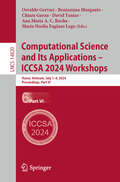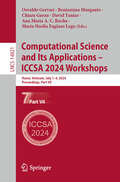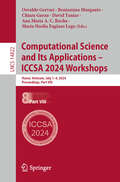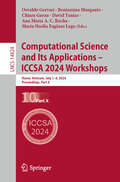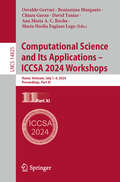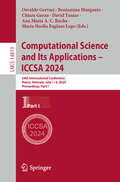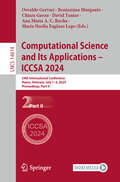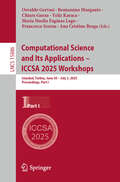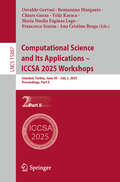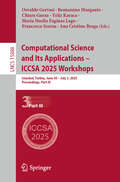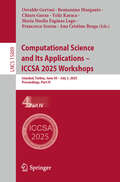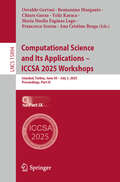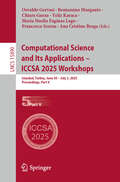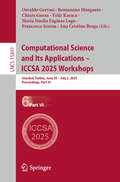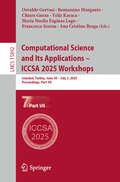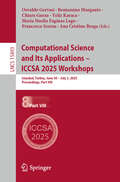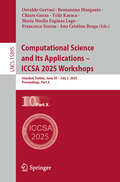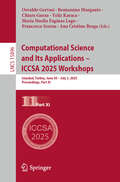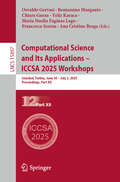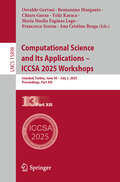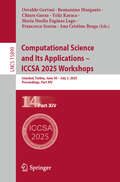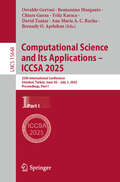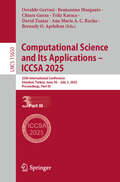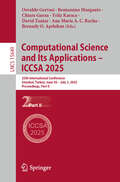- Table View
- List View
Computational Science and Its Applications – ICCSA 2024 Workshops: Hanoi, Vietnam, July 1–4, 2024, Proceedings, Part VI (Lecture Notes in Computer Science #14820)
by Osvaldo Gervasi Beniamino Murgante Ana Maria A. C. Rocha David Taniar Chiara Garau Maria Noelia Faginas LagoThis eleven-volume set LNCS 14815 – 14825 constitutes the refereed workshop proceedings of the 24th International Conference on Computational Science and Its Applications, ICCSA 2024, held at Hanoi, Vietnam, during July 1–4, 2024. The 281 full papers, 17 short papers and 2 PHD showcase papers included in this volume were carefully reviewed and selected from a total of 450 submissions. In addition, the conference consisted of 55 workshops, focusing on very topical issues of importance to science, technology and society: from new mathematical approaches for solving complex computational systems, to information and knowledge in the Internet of Things, new statistical and optimization methods, several Artificial Intelligence approaches, sustainability issues, smart cities and related technologies.
Computational Science and Its Applications – ICCSA 2024 Workshops: Hanoi, Vietnam, July 1–4, 2024, Proceedings, Part VII (Lecture Notes in Computer Science #14821)
by Osvaldo Gervasi Beniamino Murgante Ana Maria A. C. Rocha David Taniar Chiara Garau Maria Noelia Faginas LagoThis eleven-volume set LNCS 14815 – 14825 constitutes the refereed workshop proceedings of the 24th International Conference on Computational Science and Its Applications, ICCSA 2024, held at Hanoi, Vietnam, during July 1–4, 2024. The 281 full papers, 17 short papers and 2 PHD showcase papers included in this volume were carefully reviewed and selected from a total of 450 submissions. In addition, the conference consisted of 55 workshops, focusing on very topical issues of importance to science, technology and society: from new mathematical approaches for solving complex computational systems, to information and knowledge in the Internet of Things, new statistical and optimization methods, several Artificial Intelligence approaches, sustainability issues, smart cities and related technologies.
Computational Science and Its Applications – ICCSA 2024 Workshops: Hanoi, Vietnam, July 1–4, 2024, Proceedings, Part VIII (Lecture Notes in Computer Science #14822)
by Osvaldo Gervasi Beniamino Murgante Ana Maria A. C. Rocha David Taniar Chiara Garau Maria Noelia Faginas LagoThis eleven-volume set LNCS 14815 – 14825 constitutes the refereed workshop proceedings of the 24th International Conference on Computational Science and Its Applications, ICCSA 2024, held at Hanoi, Vietnam, during July 1–4, 2024. The 281 full papers, 17 short papers and 2 PHD showcase papers included in this volume were carefully reviewed and selected from a total of 450 submissions. In addition, the conference consisted of 55 workshops, focusing on very topical issues of importance to science, technology and society: from new mathematical approaches for solving complex computational systems, to information and knowledge in the Internet of Things, new statistical and optimization methods, several Artificial Intelligence approaches, sustainability issues, smart cities and related technologies.
Computational Science and Its Applications – ICCSA 2024 Workshops: Hanoi, Vietnam, July 1–4, 2024, Proceedings, Part X (Lecture Notes in Computer Science #14824)
by Osvaldo Gervasi Beniamino Murgante Ana Maria A. C. Rocha David Taniar Chiara Garau Maria Noelia Faginas LagoThis eleven-volume set LNCS 14815 – 14825 constitutes the refereed workshop proceedings of the 24th International Conference on Computational Science and Its Applications, ICCSA 2024, held at Hanoi, Vietnam, during July 1–4, 2024. The 281 full papers, 17 short papers and 2 PHD showcase papers included in this volume were carefully reviewed and selected from a total of 450 submissions. In addition, the conference consisted of 55 workshops, focusing on very topical issues of importance to science, technology and society: from new mathematical approaches for solving complex computational systems, to information and knowledge in the Internet of Things, new statistical and optimization methods, several Artificial Intelligence approaches, sustainability issues, smart cities and related technologies.
Computational Science and Its Applications – ICCSA 2024 Workshops: Hanoi, Vietnam, July 1–4, 2024, Proceedings, Part XI (Lecture Notes in Computer Science #14825)
by Osvaldo Gervasi Beniamino Murgante Ana Maria A. C. Rocha David Taniar Chiara Garau Maria Noelia Faginas LagoThis eleven-volume set LNCS 14815 – 14825 constitutes the refereed workshop proceedings of the 24th International Conference on Computational Science and Its Applications, ICCSA 2024, held at Hanoi, Vietnam, during July 1–4, 2024. The 281 full papers, 17 short papers and 2 PHD showcase papers included in this volume were carefully reviewed and selected from a total of 450 submissions. In addition, the conference consisted of 55 workshops, focusing on very topical issues of importance to science, technology and society: from new mathematical approaches for solving complex computational systems, to information and knowledge in the Internet of Things, new statistical and optimization methods, several Artificial Intelligence approaches, sustainability issues, smart cities and related technologies.
Computational Science and Its Applications – ICCSA 2024: 24th International Conference, Hanoi, Vietnam, July 1–4, 2024, Proceedings, Part I (Lecture Notes in Computer Science #14813)
by Osvaldo Gervasi Beniamino Murgante Ana Maria A. C. Rocha David Taniar Chiara Garau Maria Noelia Faginas LagoThe two-volume LNCS set 14813 and 14814 constitutes the refereed proceedings of the 24th International Conference on Computational Science and Its Applications, ICCSA 2024, held in Hanoi, Vietnam, during July 1–4, 2024. The 53 full papers, 6 short papers and 3 PHD showcase papers included in these volumes were carefully reviewed and selected from a total of 207 submissions. The papers focus on the following six sub-areas within Computer Science and its Applications: Computational Methods, Algorithms and Scientific Applications; High Performance Computing and Networks; Geometric Modeling, Graphics and Visualization; Advanced and Emerging Applications; Information Systems and Technologies & Urban and Regional Planning.
Computational Science and Its Applications – ICCSA 2024: 24th International Conference, Hanoi, Vietnam, July 1–4, 2024, Proceedings, Part II (Lecture Notes in Computer Science #14814)
by Osvaldo Gervasi Beniamino Murgante Ana Maria A. C. Rocha David Taniar Chiara Garau Maria Noelia Faginas LagoThe two-volume LNCS set 14813 and 14814 constitutes the refereed proceedings of the 24th International Conference on Computational Science and Its Applications, ICCSA 2024, held in Hanoi, Vietnam, during July 1–4, 2024. The 53 full papers, 6 short papers and 3 PHD showcase papers included in these volumes were carefully reviewed and selected from a total of 207 submissions. The papers focus on the following six sub-areas within Computer Science and its Applications: Computational Methods, Algorithms and Scientific Applications; High Performance Computing and Networks; Geometric Modeling, Graphics and Visualization; Advanced and Emerging Applications; Information Systems and Technologies & Urban and Regional Planning.
Computational Science and Its Applications – ICCSA 2025 Workshops: Istanbul, Turkey, June 30 – July 3, 2025, Proceedings, Part I (Lecture Notes in Computer Science #15886)
by Osvaldo Gervasi Beniamino Murgante Chiara Garau Yeliz Karaca Francesco Scorza Ana Cristina Braga Maria Noelia Faginas LagoThe fourteen-volume set LNCS 15886-15899 constitutes the papers of several workshops which were held in conjunction with the 25th International Conference on Computational Science and Its Applications, ICCSA 2025, held in Istanbul, Turkey, during June 30–July 3, 2025. The 362 full papers, 37 short papers and 2 PHD showcase included in this book were carefully reviewed and selected from 1043 submissions. In addition, the conference consisted of 58 workshops, focusing on very topical issues of importance to science, technology and society: from new mathematical approaches for solving complex computational systems, to information and knowledge in the Internet of Things, new statistical and optimization methods, several Artificial Intelligence approaches, sustainability issues, smart cities and related technologies.
Computational Science and Its Applications – ICCSA 2025 Workshops: Istanbul, Turkey, June 30 – July 3, 2025, Proceedings, Part II (Lecture Notes in Computer Science #15887)
by Osvaldo Gervasi Beniamino Murgante Chiara Garau Yeliz Karaca Francesco Scorza Ana Cristina Braga Maria Noelia Faginas LagoThe fourteen-volume set LNCS 15886-15899 constitutes the papers of several workshops which were held in conjunction with the 25th International Conference on Computational Science and Its Applications, ICCSA 2025, held in Istanbul, Turkey, during June 30–July 3, 2025.. The 362 full papers, 37 short papers and 2 PHD showcase included in this book were carefully reviewed and selected from 1043 submissions. In addition, the conference consisted of 58 workshops, focusing on very topical issues of importance to science, technology and society: from new mathematical approaches for solving complex computational systems, to information and knowledge in the Internet of Things, new statistical and optimization methods, several Artificial Intelligence approaches, sustainability issues, smart cities and related technologies.
Computational Science and Its Applications – ICCSA 2025 Workshops: Istanbul, Turkey, June 30 – July 3, 2025, Proceedings, Part III (Lecture Notes in Computer Science #15888)
by Osvaldo Gervasi Beniamino Murgante Chiara Garau Yeliz Karaca Francesco Scorza Ana Cristina Braga Maria Noelia Faginas LagoThe fourteen-volume set LNCS 15886-15899 constitutes the papers of several workshops which were held in conjunction with the 25th International Conference on Computational Science and Its Applications, ICCSA 2025, held in Istanbul, Turkey, during June 30–July 3, 2025. The 362 full papers, 37 short papers and 2 PHD showcase included in this book were carefully reviewed and selected from 1043 submissions. In addition, the conference consisted of 58 workshops, focusing on very topical issues of importance to science, technology and society: from new mathematical approaches for solving complex computational systems, to information and knowledge in the Internet of Things, new statistical and optimization methods, several Artificial Intelligence approaches, sustainability issues, smart cities and related technologies.
Computational Science and Its Applications – ICCSA 2025 Workshops: Istanbul, Turkey, June 30 – July 3, 2025, Proceedings, Part IV (Lecture Notes in Computer Science #15889)
by Osvaldo Gervasi Beniamino Murgante Chiara Garau Yeliz Karaca Francesco Scorza Ana Cristina Braga Maria Noelia Faginas LagoThe fourteen-volume set LNCS 15886-15899 constitutes the papers of several workshops which were held in conjunction with the 25th International Conference on Computational Science and Its Applications, ICCSA 2025, held in Istanbul, Turkey, during June 30–July 3, 2025. The 362 full papers, 37 short papers and 2 PHD showcase included in this book were carefully reviewed and selected from 1043 submissions. In addition, the conference consisted of 58 workshops, focusing on very topical issues of importance to science, technology and society: from new mathematical approaches for solving complex computational systems, to information and knowledge in the Internet of Things, new statistical and optimization methods, several Artificial Intelligence approaches, sustainability issues, smart cities and related technologies.
Computational Science and Its Applications – ICCSA 2025 Workshops: Istanbul, Turkey, June 30 – July 3, 2025, Proceedings, Part IX (Lecture Notes in Computer Science #15894)
by Osvaldo Gervasi Beniamino Murgante Chiara Garau Yeliz Karaca Francesco Scorza Ana Cristina Braga Maria Noelia Faginas LagoThe fourteen-volume set LNCS 15886-15899 constitutes the papers of several workshops which were held in conjunction with the 25th International Conference on Computational Science and Its Applications, ICCSA 2025, held in Istanbul, Turkey, during June 30–July 3, 2025. The 362 full papers, 37 short papers and 2 PHD showcase included in this book were carefully reviewed and selected from 1043 submissions. In addition, the conference consisted of 58 workshops, focusing on very topical issues of importance to science, technology and society: from new mathematical approaches for solving complex computational systems, to information and knowledge in the Internet of Things, new statistical and optimization methods, several Artificial Intelligence approaches, sustainability issues, smart cities and related technologies.
Computational Science and Its Applications – ICCSA 2025 Workshops: Istanbul, Turkey, June 30 – July 3, 2025, Proceedings, Part V (Lecture Notes in Computer Science #15890)
by Osvaldo Gervasi Beniamino Murgante Chiara Garau Yeliz Karaca Francesco Scorza Ana Cristina Braga Maria Noelia Faginas LagoThe fourteen-volume set LNCS 15886-15899 constitutes the papers of several workshops which were held in conjunction with the 25th International Conference on Computational Science and Its Applications, ICCSA 2025, held in Istanbul, Turkey, during June 30–July 3, 2025. The 362 full papers, 37 short papers and 2 PHD showcase included in this book were carefully reviewed and selected from 1043 submissions. In addition, the conference consisted of 58 workshops, focusing on very topical issues of importance to science, technology and society: from new mathematical approaches for solving complex computational systems, to information and knowledge in the Internet of Things, new statistical and optimization methods, several Artificial Intelligence approaches, sustainability issues, smart cities and related technologies.
Computational Science and Its Applications – ICCSA 2025 Workshops: Istanbul, Turkey, June 30 – July 3, 2025, Proceedings, Part VI (Lecture Notes in Computer Science #15891)
by Osvaldo Gervasi Beniamino Murgante Chiara Garau Yeliz Karaca Francesco Scorza Ana Cristina Braga Maria Noelia Faginas LagoThe fourteen-volume set LNCS 15886-15899 constitutes the papers of several workshops which were held in conjunction with the 25th International Conference on Computational Science and Its Applications, ICCSA 2025, held in Istanbul, Turkey, during June 30–July 3, 2025. The 362 full papers, 37 short papers and 2 PHD showcase included in this book were carefully reviewed and selected from 1043 submissions. In addition, the conference consisted of 58 workshops, focusing on very topical issues of importance to science, technology and society: from new mathematical approaches for solving complex computational systems, to information and knowledge in the Internet of Things, new statistical and optimization methods, several Artificial Intelligence approaches, sustainability issues, smart cities and related technologies.
Computational Science and Its Applications – ICCSA 2025 Workshops: Istanbul, Turkey, June 30 – July 3, 2025, Proceedings, Part VII (Lecture Notes in Computer Science #15892)
by Osvaldo Gervasi Beniamino Murgante Chiara Garau Yeliz Karaca Francesco Scorza Ana Cristina Braga Maria Noelia Faginas LagoThe fourteen-volume set LNCS 15886-15899 constitutes the papers of several workshops which were held in conjunction with the 25th International Conference on Computational Science and Its Applications, ICCSA 2025, held in Istanbul, Turkey, during June 30–July 3, 2025. The 362 full papers, 37 short papers and 2 PHD showcase included in this book were carefully reviewed and selected from 1043 submissions. In addition, the conference consisted of 58 workshops, focusing on very topical issues of importance to science, technology and society: from new mathematical approaches for solving complex computational systems, to information and knowledge in the Internet of Things, new statistical and optimization methods, several Artificial Intelligence approaches, sustainability issues, smart cities and related technologies.
Computational Science and Its Applications – ICCSA 2025 Workshops: Istanbul, Turkey, June 30 – July 3, 2025, Proceedings, Part VIII (Lecture Notes in Computer Science #15893)
by Osvaldo Gervasi Beniamino Murgante Chiara Garau Yeliz Karaca Francesco Scorza Ana Cristina Braga Maria Noelia Faginas LagoThe fourteen-volume set LNCS 15886-15899 constitutes the papers of several workshops which were held in conjunction with the 25th International Conference on Computational Science and Its Applications, ICCSA 2025, held in Istanbul, Turkey, during June 30–July 3, 2025. The 362 full papers, 37 short papers and 2 PHD showcase included in this book were carefully reviewed and selected from 1043 submissions. In addition, the conference consisted of 58 workshops, focusing on very topical issues of importance to science, technology and society: from new mathematical approaches for solving complex computational systems, to information and knowledge in the Internet of Things, new statistical and optimization methods, several Artificial Intelligence approaches, sustainability issues, smart cities and related technologies.
Computational Science and Its Applications – ICCSA 2025 Workshops: Istanbul, Turkey, June 30 – July 3, 2025, Proceedings, Part X (Lecture Notes in Computer Science #15895)
by Osvaldo Gervasi Beniamino Murgante Chiara Garau Yeliz Karaca Francesco Scorza Ana Cristina Braga Maria Noelia Faginas LagoThe fourteen-volume set LNCS 15886-15899 constitutes the papers of several workshops which were held in conjunction with the 25th International Conference on Computational Science and Its Applications, ICCSA 2025, held in Istanbul, Turkey, during June 30–July 3, 2025. The 362 full papers, 37 short papers and 2 PHD showcase included in this book were carefully reviewed and selected from 1043 submissions. In addition, the conference consisted of 58 workshops, focusing on very topical issues of importance to science, technology and society: from new mathematical approaches for solving complex computational systems, to information and knowledge in the Internet of Things, new statistical and optimization methods, several Artificial Intelligence approaches, sustainability issues, smart cities and related technologies.
Computational Science and Its Applications – ICCSA 2025 Workshops: Istanbul, Turkey, June 30 – July 3, 2025, Proceedings, Part XI (Lecture Notes in Computer Science #15896)
by Osvaldo Gervasi Beniamino Murgante Chiara Garau Yeliz Karaca Francesco Scorza Ana Cristina Braga Maria Noelia Faginas LagoThe fourteen-volume set LNCS 15886-15899 constitutes the papers of several workshops which were held in conjunction with the 25th International Conference on Computational Science and Its Applications, ICCSA 2025, held in Istanbul, Turkey, during June 30–July 3, 2025. The 362 full papers, 37 short papers and 2 PHD showcase included in this book were carefully reviewed and selected from 1043 submissions. In addition, the conference consisted of 58 workshops, focusing on very topical issues of importance to science, technology and society: from new mathematical approaches for solving complex computational systems, to information and knowledge in the Internet of Things, new statistical and optimization methods, several Artificial Intelligence approaches, sustainability issues, smart cities and related technologies.
Computational Science and Its Applications – ICCSA 2025 Workshops: Istanbul, Turkey, June 30 – July 3, 2025, Proceedings, Part XII (Lecture Notes in Computer Science #15897)
by Osvaldo Gervasi Beniamino Murgante Chiara Garau Yeliz Karaca Francesco Scorza Ana Cristina Braga Maria Noelia Faginas LagoThe fourteen-volume set LNCS 15886-15899 constitutes the papers of several workshops which were held in conjunction with the 25th International Conference on Computational Science and Its Applications, ICCSA 2025, held in Istanbul, Turkey, during June 30–July 3, 2025. The 362 full papers, 37 short papers and 2 PHD showcase included in this book were carefully reviewed and selected from 1043 submissions. In addition, the conference consisted of 58 workshops, focusing on very topical issues of importance to science, technology and society: from new mathematical approaches for solving complex computational systems, to information and knowledge in the Internet of Things, new statistical and optimization methods, several Artificial Intelligence approaches, sustainability issues, smart cities and related technologies.
Computational Science and Its Applications – ICCSA 2025 Workshops: Istanbul, Turkey, June 30 – July 3, 2025, Proceedings, Part XIII (Lecture Notes in Computer Science #15898)
by Osvaldo Gervasi Beniamino Murgante Chiara Garau Yeliz Karaca Francesco Scorza Ana Cristina Braga Maria Noelia Faginas LagoThe fourteen-volume set LNCS 15886-15899 constitutes the papers of several workshops which were held in conjunction with the 25th International Conference on Computational Science and Its Applications, ICCSA 2025, held in Istanbul, Turkey, during June 30–July 3, 2025. The 362 full papers, 37 short papers and 2 PHD showcase included in this book were carefully reviewed and selected from 1043 submissions. In addition, the conference consisted of 58 workshops, focusing on very topical issues of importance to science, technology and society: from new mathematical approaches for solving complex computational systems, to information and knowledge in the Internet of Things, new statistical and optimization methods, several Artificial Intelligence approaches, sustainability issues, smart cities and related technologies.
Computational Science and Its Applications – ICCSA 2025 Workshops: Istanbul, Turkey, June 30 – July 3, 2025, Proceedings, Part XIV (Lecture Notes in Computer Science #15899)
by Osvaldo Gervasi Beniamino Murgante Chiara Garau Yeliz Karaca Francesco Scorza Ana Cristina Braga Maria Noelia Faginas LagoThe 362 full papers, 37 short papers and 2 PHD showcase included in this book were carefully reviewed and selected from 1043 submissions. In addition, the conference consisted of 58 workshops, focusing on very topical issues of importance to science, technology and society: from new mathematical approaches for solving complex computational systems, to information and knowledge in the Internet of Things, new statistical and optimization methods, several Artificial Intelligence approaches, sustainability issues, smart cities and related technologies.
Computational Science and Its Applications – ICCSA 2025: 25th International Conference, Istanbul, Turkey, June 30 – July 3, 2025, Proceedings, Part I (Lecture Notes in Computer Science #15648)
by Osvaldo Gervasi Beniamino Murgante Ana Maria A. C. Rocha David Taniar Bernady O. Apduhan Chiara Garau Yeliz KaracaThe three-volumes LNCS 15648, 15649, 15650 set constitutes the refereed proceedings of the 25th International Conference on Computational Science and Its Applications - ICCSA 2025, held in Istanbul, Turkey, during June 30–July 3, 2025. The 71 full papers, 6 short papers, and 1 PHD showcase paper were carefully reviewed and selected from 269 submissions. The papers have been organized in topical sections as follows: Part I: Computational Methods, Algorithms and Scientific Applications; High Performance Computing and Networks; Geometric Modeling, Graphics and Visualization; Advanced and Emerging Applications; Information Systems and Technologies; Urban and Regional Planning. Part II: Information Systems and Technologies; Part III: Information Systems and Technologies; Urban and Regional Planning; PHD Showcase Paper; Short papers.
Computational Science and Its Applications – ICCSA 2025: 25th International Conference, Istanbul, Turkey, June 30 – July 3, 2025, Proceedings, Part III (Lecture Notes in Computer Science #15650)
by Osvaldo Gervasi Beniamino Murgante Ana Maria A. C. Rocha David Taniar Bernady O. Apduhan Chiara Garau Yeliz KaracaT The three-volumes LNCS 15648, 15649, 15650 set constitutes the refereed proceedings of the 25th International Conference on Computational Science and Its Applications - ICCSA 2025, held in Istanbul, Turkey, during June 30–July 3, 2025. The 71 full papers, 6 short papers, and 1 PHD showcase paper were carefully reviewed and selected from 269 submissions. The papers have been organized in topical sections as follows: Part I: Computational Methods, Algorithms and Scientific Applications; High Performance Computing and Networks; Geometric Modeling, Graphics and Visualization; Advanced and Emerging Applications; Information Systems and Technologies; Urban and Regional Planning. Part II: Information Systems and Technologies; Part III: Information Systems and Technologies; Urban and Regional Planning; PHD Showcase Paper; Short papers.
Computational Science and Its Applications – ICCSA 2025: 25th International Conference, Istanbul, Turkey, June 30–July 3, 2025, Proceedings, Part II (Lecture Notes in Computer Science #15649)
by Osvaldo Gervasi Beniamino Murgante Ana Maria A. C. Rocha David Taniar Bernady O. Apduhan Chiara Garau Yeliz KaracaThe three-volumes LNCS 15648, 15649, 15650 set constitutes the refereed proceedings of the 25th International Conference on Computational Science and Its Applications - ICCSA 2025, held in Istanbul, Turkey, during June 30–July 3, 2025. The 71 full papers, 6 short papers, and 1 PHD showcase paper were carefully reviewed and selected from 269 submissions. The papers have been organized in topical sections as follows: Part I: Computational Methods, Algorithms and Scientific Applications; High Performance Computing and Networks; Geometric Modeling, Graphics and Visualization; Advanced and Emerging Applications; Information Systems and Technologies; Urban and Regional Planning. Part II: Information Systems and Technologies; Part III: Information Systems and Technologies; Urban and Regional Planning; PHD Showcase Paper; Short papers.
Computational Science and Technology: 7th ICCST 2020, Pattaya, Thailand, 29–30 August, 2020 (Lecture Notes in Electrical Engineering #724)
by Patricia Anthony Hiroyuki Iida Rayner Alfred Haviluddin HaviluddinThis book gathers the proceedings of the Seventh International Conference on Computational Science and Technology 2020 (ICCST 2020), held in Pattaya, Thailand, on 29–30 August 2020. The respective contributions offer practitioners and researchers a range of new computational techniques and solutions, identify emerging issues, and outline future research directions, while also showing them how to apply the latest large-scale, high-performance computational methods.
